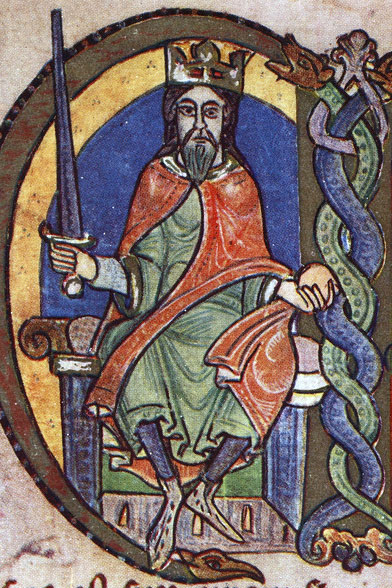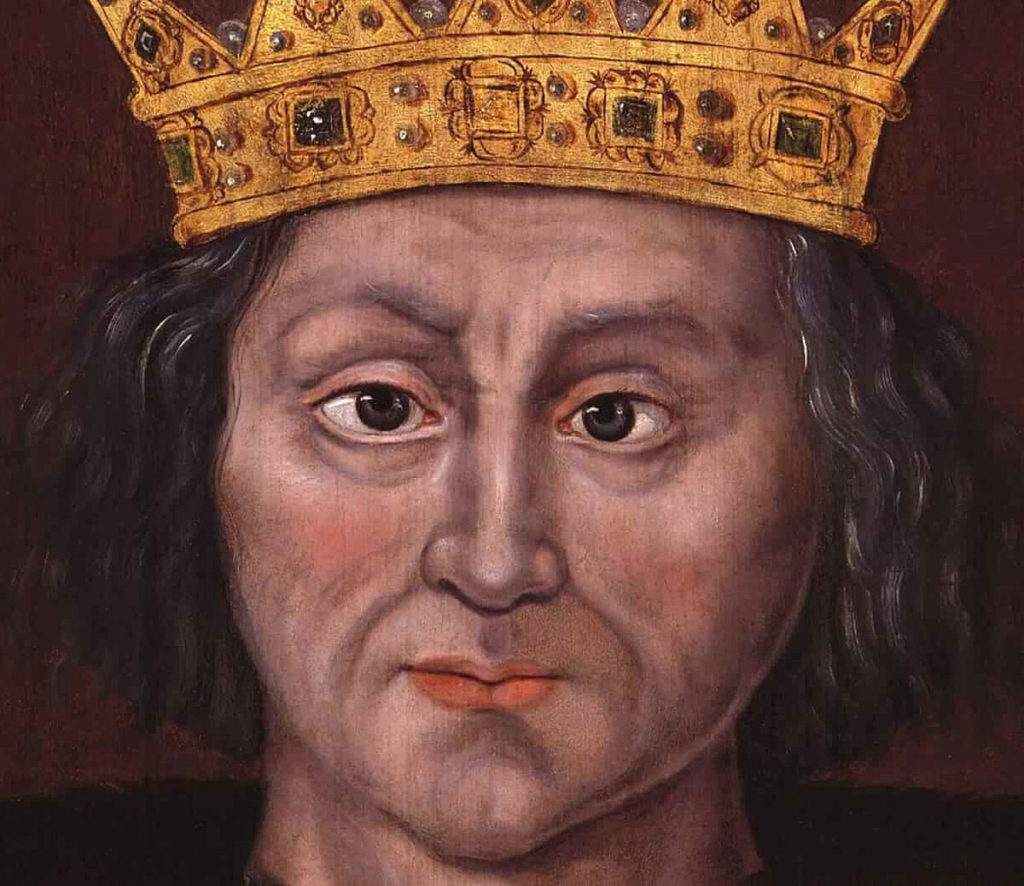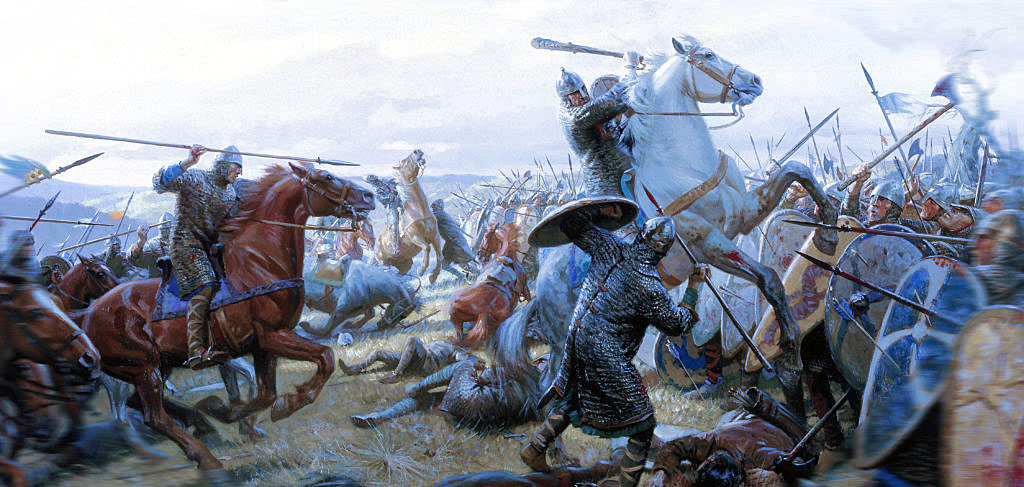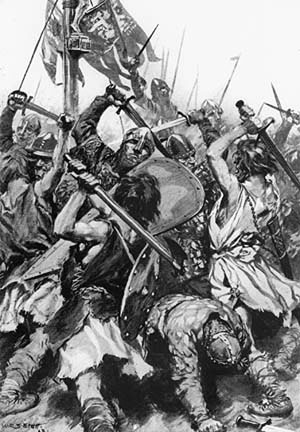The battle around the sacred standard, comprising the banners of St Peter of York, St Wilfred of Ripon and St John of Beverley, between the English and the Scots on 22nd August 1138
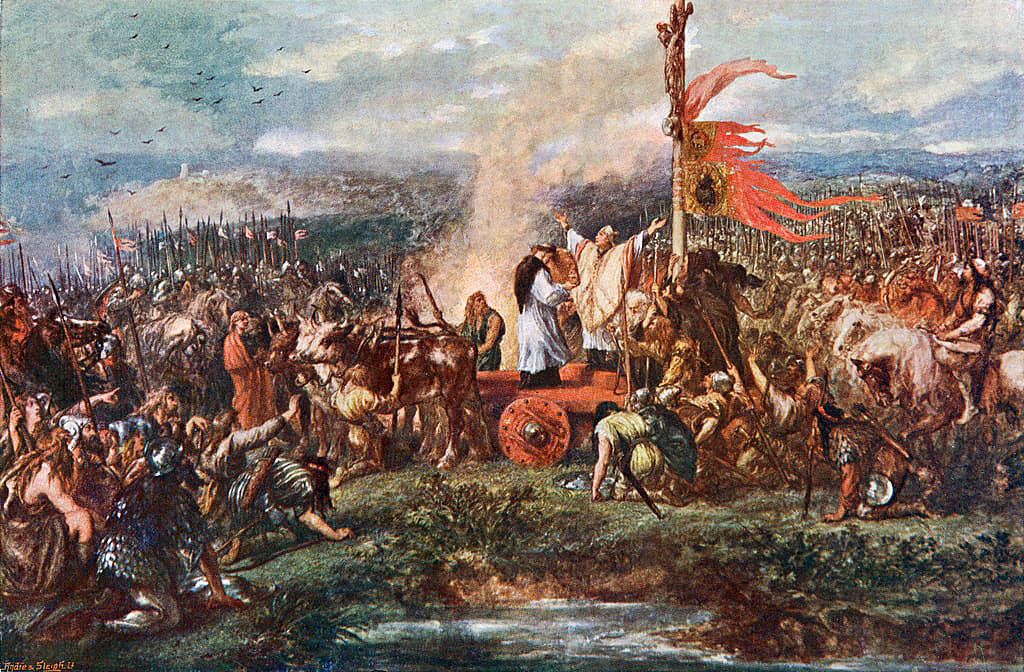
The previous battle in the British Battles series is the Battle of Hastings
The next battle in the Barons’ Wars is Lewes
War: The Barons’ War.
Date of the Battle of The Standard: 22nd August 1138
Place of the Battle of The Standard: Northallerton in North Yorkshire.
Combatants at the Battle of The Standard: A Scottish army with rebel English barons against the feudal levies and fyrd of Yorkshire fighting to repel the Scots invasion.
Commanders at the Battle of The Standard: King David I of Scotland against William, Earl of Albemarle and Walter L’Espec commanding the English army on behalf of King Stephen.
Size of the armies at the Battle of The Standard: The Scottish army is said to have numbered around 10,000 men and the English army around 8,000 men.
Uniforms, arms and equipment at the Battle of The Standard: Knights and mounted men-at-arms wore chain mail reinforced by metal plates at knees and elbows and steel helmets and were armed with lance, Shield and sword.
The men of the English fyrd and the Scottish countrymen were armed with such weapons as each man might own from cutting or pointed agricultural instruments to swords, shields, spears and bows.
The highlanders carried target shields and were armed with two-handed swords or pole-axes.
Winner of the Battle of The Standard: The Scots failed to break up the English line and were forced into a retreat with heavy casualties.
Events leading to the Battle of The Standard:
King Henry I of England died in 1135. Henry’s son Prince William had died in the loss of the White Ship, leaving Matilda as Henry’s sole surviving legitimate child.
Henry compelled the leading barons of England to accept Matilda as their next ruler, but on his death the barons reneged on their agreement, many of the them supporting Henry’s nephew, Stephen of Blois, who became the next monarch of England.
The dispute led to warfare between the supporters of Matilda and Stephen.
King David I of Scotland, whose sister was married to King Henry I, vigorously supported his niece Matilda and embarked on a series of invasions of the north of England.
In March 1137 King David again invaded the north of England with a Scottish army.
After crossing the border, King David despatched his nephew William with a force of Galloway men to despoil the west of England, while King David with the greater part of his army laid siege to the castle of Norham on the River Tweed.
Capturing Norham, King David marched south through Northumberland and Durham into Yorkshire, approaching Alverton, now known as Northallerton, in the north of the county.
King Stephen was hard pressed in the south of England resisting the revolt of many of the barons and left the defence of the north to the local leaders.
The Scots committed extensive atrocities on the English civil population as they advanced, leading the English to look on their resistance as a form of religious crusade.
The defence against the invading Scots was galvanised by the aged Thurstan, Archbishop of York.
Thurstan ordered the clerics of Yorkshire to process with their crosses, banners and relics and to assemble all men capable of bearing arms at Thirsk under the northern English barons.
Archbishop Thurstan presented his banner to the senior barons gathering to lead the army, in particular William, Earl of Albemarle and Walter L’Espec.
Account of the Battle of The Standard:
The English army took up position on Culverton Moor to the north of Alverton, later known as Northallerton.
On the moor, the English soldiers erected a standard, comprising a ship’s mast lashed to a four-wheeled cart with a crucifix at its head and the banners of the three patron saints of Yorkshire attached below, Peter of York, Wilfred of Ripon and John of Beverley.
This device gave the battle its name, the Battle of the Standard.
Walter l’Espec harangued the English troops from the cart and gave his ungauntleted hand to William, Earl of Albermarle, exclaiming, ‘I pledge thee my troth to conquer or to die.’
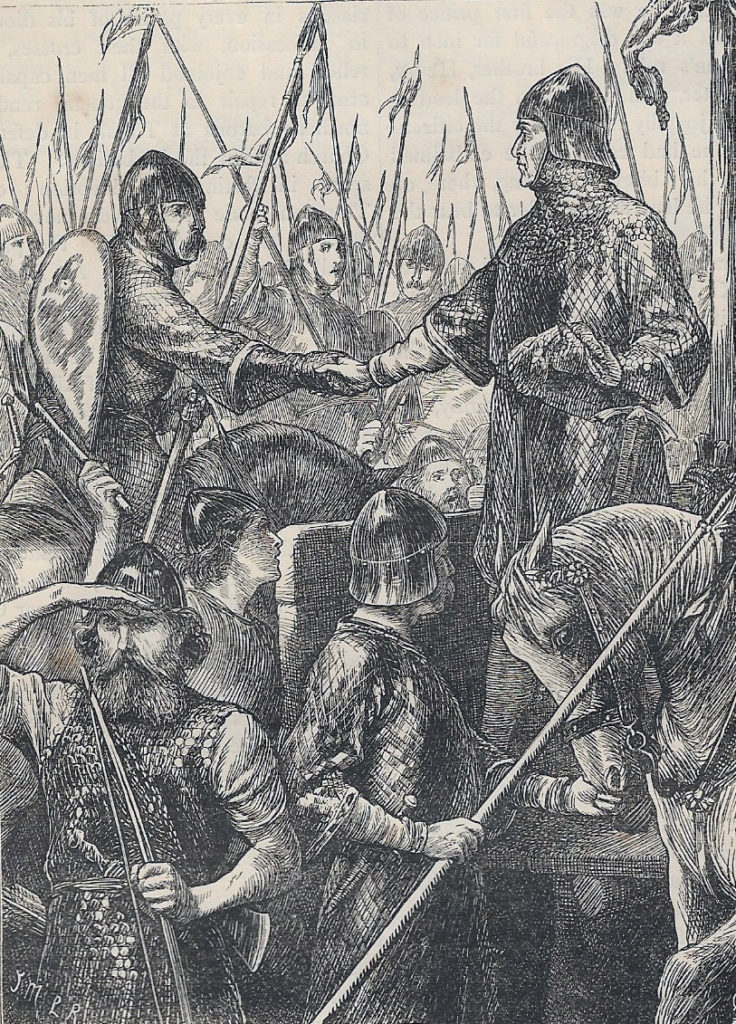
The representative of Archbishop Thurstan gave an address to the assembled knights at the end of which the lines of the advancing Scots army came into sight.
The English knights dismounted and sent their horses to the rear, forming a long line with the infantrymen, facing the advancing Scots, the chariot containing the Standard in the rear.
Archers from Yorkshire mingled with the other soldiers, rather than forming a distinct block.
A group of senior knights formed a ‘sacred band’ around the Standard.
The advancing Scots army was larger than the English force, although substantially weaker in numbers of knights and archers, the majority being highlanders and Picts of Galloway, armed with target shields and broadswords.
The Scottish King David ordered his knights to take the head of the Scots column with the archers and to spearhead the attack.
At this order a furious row broke out in the Scottish ranks.
The Highlander and Galloway were not prepared to permit the lowland knights and archers to strike the first blow.
When King David persisted in maintaining this formation, the Earl of Strathearn denounced his reliance on ‘Frenchmen’ and insisted that without armour he would force his way into the English ranks.
King David was forced to abandon his plan of attack and permit the Galloway men to lead the assault.
The reformed army advanced in several lines.
The Galloway men led the centre of the first line. The right wing of the first line was commanded by Prince Henry, the king’s son, leading the lowland knights, with a bodyguard of men-at-arms under Eustace Fitzjohn, a Norman baron of Northumberland who had turned against King Stephen after the English king took from him the Castle of Bamborough and the levies of Strathclyde and Teviotdale.
On the left wing of the first Scottish line were the English speakers of Lothian and the Highland clans of Lorn, Argyle and the Hebrides.
The second line of the Scottish army comprised the Highland and Island clans armed with target shields, two-handed claymores and pole-axes.
King David led the reserve of a body of Saxon and Norman knights and men-at-arms with the men from Moray in the rear.
As the Scottish army advanced against the English, Robert Bruce, a baron from Yorkshire also holding land in Annandale in Scotland, with Bernard de Baliol, rode up to King David and attempted to persuade him to enter into a truce with the English, offering to obtain from King Stephen a grant of the earldom of Northumberland for King David’s son Prince Henry.
Bruce was driven away by the Scottish knights who called him a traitor.
The men of Galloway reached the English first and attacked the centre of the English line, shouting their war-cry ‘Albanach, Albanach.’
The English common soldiers in the line were severely shaken by the savage attack of the men of Galloway and began to fall back, but the stiffening of knights was sufficient to hold the attack and restore the English line, driving back the men of Galloway.
The men of Galloway renewed their assault, but were unable to break into the English line for a second time.
The men of Galloway delivered a number of further assaults of diminishing ferocity.
Throughout their onslaught they were severely galled by the continuous discharge of arrows by the English archers.
Some of the Scots are said to have looked like pincushions from the number of arrows stuck in their bodies.
On the Scots right wing, Prince Henry came up with his knights and the men from Strathclyde and Teviot, the knights leading the charge on horseback.
Prince Henry and his men hacked their way through the Yorkshire levies, the survivors emerging on the far side of the English line.
Henry’s men saw the English horses held riderless some distance behind the English line and made for them, in the expectation that the rest of the Scottish first line would follow them through the gap in the English army.
In fact, the English troops closed up behind the Scottish knights and drove back the men of Strathclyde.
In the centre, the impetus of the Scottish attack had been lost and the men of Galloway dispersed and left the battlefield, leaving the bodies of their chiefs, Donald and Ulgerich.
On the left wing the men of Lothian and Lorn made one feeble attack and then turned and left the battlefield.
King David attempted to lead the Highlanders of the reserve in an attack to support his son and the centre and right of the first line, but the Highlanders, seeing the battle going badly for the Scots, melted away, leaving King David with his bodyguard of knights.
King David withdrew to a hill where he assembled the remains of his army that had not fled the field.
Prince Henry, finding himself isolated behind the English line with the few survivors of his body of Scottish knights, joined the advance of the English army, unnoticed until he was able to slip away and join his father’s retreating troops as they withdrew into Scotland.
Casualties at the Battle of The Standard:
Putting a number on the casualties is as difficult as assessing the numbers in each army before the battle.
Of the 200 knights Prince Henry led into the attack only 19 returned, the rest being casualties or prisoners of the English.
Heavy casualties were suffered by the men of Galloway and many of the chiefs in the centre and right of the Scots first line fell in the battle.
Few of the English knights were killed or wounded, but the casualties among the ordinary members of the English Fyrd were heavy, although unrecorded.
Follow-up to the Battle of The Standard:
Following the Battle of the Standard, King David marched to Carlisle where he awaited his son, Prince Henry.
The Scots then attacked and took the Castle of Wark, owned by Walter l’Espec, before withdrawing into Scotland.
In the subsequent settlement, Stephen the English King ceded most of Northumberland to Prince Henry, in effect conceding that the Scots had won the war.
Anecdotes and traditions from the Battle of The Standard:
- The Galloway war cry ‘Albanach, Albanach’ translated as ‘Men of Scotland, Men of Scotland’. It is said that the English called back ‘Men of Ireland, Men of Ireland’, intending a mortal insult.
- An almost certainly apocryphal story claims that the deciding moment in the Battle of the Standard was when an English soldier held up a severed human head on his spear and called ‘Behold the head of the King of the Scots’, causing consternation among the men of Galloway who immediately fell back from their attack and beginning the rout of the Scots army. One of the difficulties with this story is that the men of Galloway did not speak English.
References for the Battle of The Standard:
A History of the Art of War in the Middle Ages Volume One 378-1278AD by Sir Charles Oman
British Battles of Land and Sea
British Battles by Grant.
The previous battle in the British Battles series is the Battle of Hastings
The next battle in the Barons’ Wars is Lewes
